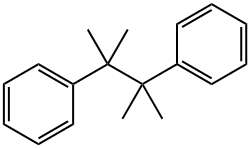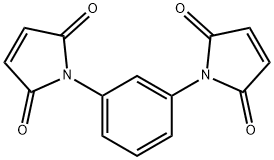
1889-67-4
- Product Name:Benzene,1,1'-(1,1,2,2-tetramethyl-1,2-ethanediyl)bis-
- Molecular Formula:C18H22
- Purity:99%
- Molecular Weight:
Product Details;
CasNo: 1889-67-4
Molecular Formula: C18H22
Appearance: white to light yellow flakes, crystalline powder
1889-67-4 Properties
- Molecular Formula:C18H22
- Molecular Weight:238.373
- Appearance/Colour:white to light yellow flakes, crystalline powder
- Vapor Pressure:0.00143mmHg at 25°C
- Melting Point:90-110 °C
- Refractive Index:1.534
- Boiling Point:306.1 °C at 760 mmHg
- Flash Point:142.7 °C
- PSA:0.00000
- Density:0.95 g/cm3
- LogP:4.94200
1889-67-4 Usage
InChI:InChI=1/C18H22/c1-17(2,15-11-7-5-8-12-15)18(3,4)16-13-9-6-10-14-16/h5-14H,1-4H3
1889-67-4 Relevant articles
Solid-state photodecarbonylation of diphenylcyclopropenone: A quantum chain process made possible by ultrafast energy transfer
Kuzmanich, Gregory,Natarajan, Arunkumar,Chin, Khin K.,Veerman, Marcel,Mortko, Christopher J.,Garcia-Garibay, Miguel A.
, p. 1140 - 1141 (2008)
It has been reported that electronic excitation of diphenylcyclopropenone (DPCP) into the second excited state (S2) results in an adiabatic ring-opening process within 200 fs to give an excited product with a lifetime of ca. 8 ps in S2. Knowing that energy transfer in crystals may occur within 1-2 ps, we recognized that the conditions could be right for a quantum chain process with the excited-state product sensitizing a neighboring ground-state reactant to set up a domino effect. In agreement with that, we discovered that excitation or macroscopic crystals result in a remarkably efficient reaction to give diphenylacetylene as a polycrystalline powder by a process that releases a great deal of mechanical energy. By taking advantage of nanocrystalline suspensions and using dicumyl ketone as an internal actinometer and after accounting for differences in absorbance at the irradiation wavelength, we were able to establish that the quantum yield of the reaction for DPCP was ΦDPCP = 3.30 ± 0.35, which is well above unity and consistent with a remarkable quantum chain process. Copyright
The electrochemical reduction of α-nitrocumene in a protic and basic medium on large surface area (porous) electrodes: Electronation-protonation or electrocatalytic hydrogenation?
Chan-Shing, Elisa Soazara,Boucher, Denys,Lessard, Jean
, p. 687 - 694 (1999)
The electrochemical reduction of α-nitrocumene (1) has been investigated under controlled potential, at a mercury pool cathode and at Raney metal (Raney nickel, Raney cobalt and Devarda copper) and fractal nickel electrodes in basic aqueous ethanol. A comparison of the product distribution from the reduction at Hg (electronation-protonation (EP) mechanism) and that from the reduction at Raney metals and fractal nickel has shown that both the electrocatalytic hydrogenation (ECH) and EP mechanisms can be involved at large surface area (porous) transition metal electrodes in a basic protic medium. Cyclic voltammetry was used to determine the reduction potential of 1 at Hg and at bright polycrystalline nickel, cobalt, and copper cathodes in the same medium.
Photo-Fries reaction in water made selective with a capsule
Kaanumalle, Lakshmi S.,Gibb, Corinne L. D.,Gibb, Bruce C.,Ramamurthy
, p. 236 - 238 (2007)
The water soluble capsule formed by a deep cavity cavitand with eight carboxylic acid groups controls product distribution during photo-Fries rearrangement of naphthyl esters in water by restricting the mobility of primary singlet radical pair. The Royal Society of Chemistry.
Large-scale photochemical reactions of nanocrystalline suspensions: A promising green chemistry method
Veerman, Marcel,Resendiz, Marino J. E.,Garcia-Garibay, Miguel A.
, p. 2615 - 2617 (2006)
Photochemical reactions in the solid state can be scaled up from a few milligrams to 10 grams by using colloidal suspensions of a photoactive molecular crystal prepared by the solvent shift method. Pure products are recovered by filtration, and the use of H2O as a suspension medium makes this method a very attractive one from a green chemistry perspective. Using the photodecarbonylation of dicumyl ketone (DCK) as a test system, we show that reaction efficiencies in colloidal suspensions rival those observed in solution.
The Thermal Decomposition of 1-Methyl-1-phenylethyl 2,2-Dimethylperoxypropionate in Cumene
Komai, Takeshi,Kato, Kenji,Matsuyama, Kazuo
, p. 2641 - 2642 (1988)
The thermal decomposition of 1-methyl-1-phenylethyl 2,2-dimethylperoxypropionate was studied in cumene.Based on the kinetic parameters and the decomposition products, it was concluded that the peroxyester was decomposed mainly by means of the radical process in cumene.
Enhanced cage effects in supercritical fluid solvents. The behavior of diffusive and geminate caged-pairs in supercritical carbon dioxide
Tanko,Pacut
, p. 5703 - 5709 (2001)
The behavior of geminate and diffusive radical caged-pairs arising from the photolysis of dicumyl ketone in conventional and supercritical carbon dioxide (SC-CO2) solvents has been examined. The results suggest that locally enhanced solvent density about a solute (solvent/solute clustering) can lead to an enhanced cage effect near the critical pressure in supercritical fluid solvents. This enhanced cage effect is similar in magnitude for both diffusive and geminate caged-pairs.
Molecular rearrangement. 36. Selective α-CH oxidation of alkylarenes by nitrogen dioxide on thermolysis with nitramines
Badr, Mahmoud Z. A.
, p. 6706 - 6710 (2004)
Thermolysis of 2,4,6-trichloro-N-nitroaniline 1 and N-methyl-2,4-dinitro-N- nitroaniline 2 each with primaryl alkylbenzenes led to the formation of acylbenzenes. Similar reactions with secondary alkylbenzenes afforded a mixture of acetophenone and aliphatic aldehydes. Use of tert-butylbenzene in this reaction yielded formaldehyde and 2,3-diphenyl-2,3-dimethylbutane. The mechanisms of the studied reactions are discussed.
Oxidation of Isopropylbenzene by Iron Tetraphenylporphyrin: Evidence for the Interaction of the Cumyl Radical with Oxygen Donors
Baciocchi, Enrico,d'Acunzo, Francesca,Galli, Carlo,Ioele, Marcella
, p. 429 - 430 (1995)
Evidence is presented for an unprecedented oxygen transfer from oxygen donors to a cumyl radical in the oxidation of isopropylbenzene catalysed by tetraphenyl metalloporphyrins.
-
Hey et al.
, p. 1463,1468, 1469 (1956)
-
Synthesis and Thermal Decomposition of Di-t-Butyl Peroxydicarbonate
Komai, Takeshi,Matsuyama, Kazuo
, p. 2207 - 2211 (1985)
Di-t-butyl peroxydicarbonate(DBPD) has been synthesized in a novel route and thermally decomposed at 40-70 deg C.The decomposition exhibits first-order kinetics and the values of ΔH* and ΔS* are 122 kJ mol-1 and 46 J K-1 mol-1, respectively. 2-Methyl-2-propanol is obtained quantitatively as a decomposition product and the rates are a little dependant on the viscosities of solvents, normal alkanes.The mechanism that involves the initial scission of the O-O bond is discussed and the values of the rates and the activation parameters of DBPD are compared withthose of diacetyl peroxide and dibenzoyl peroxide.
Carbon Acidity. 67. The Indicator Scale of Cesium Ion Pairs in Tetrahydrofuran
Bors, Daniel A.,Kaufman, Michael J.,Streitwieser, Andrew Jr.
, p. 6975 - 6982 (1985)
An equilibrium cesium ion-pair indicator scale relative to 9-phenylfluorene at pKa = 18.49 has been established for 22 hydrocarbons in tetrahydrofuran.Comparison of this scale to those developed in Me2So and DME shows the scale to be independent of solvent.Visible absorbance spectral characteristics of the indicator anions are also reported and discussed in relation to other solvents.Thermodynamic studies of the equilibrium reactions were carried out over a temperature range of -20 to 25 deg C and reveal the importance of internal rotation on the entropy of reactions.Thermodynamic constants found for reaction between fluorenes show a complex behavior and are generally not interpretable at this time.
Pressure Effects on Azocumene Decomposition Rates, Efficiencies of Radical Production, and Semibenzene Dimers
Neuman, Robert C.,Amrich, Michael J.
, p. 4629 - 4636 (1980)
Rates of thermal decomposition of azocumene (1a) and p,p'-dimethylazocumene (1b) in cumene or chlorobenzene are decreased by pressure with decomposition activation volumes of +5 cm3/mol (1a,cumene), +4.3 cm3/mol (1a,chlorobenzene) and +4.6 cm3/mol (1b,cumene).Efficiencies (f) of radical production, with di-tert-butyl nitroxide (DBNO) or thiophenol as scavengers, decrease with pressure; however, the pressure dependence of f with DBNO is anomalous.This is explained by the formation of semibenzene dimers as cage products, which subsequently decompose to give cumyl radicals.The corresponding α-ortho semibenzene dimers of cumyl radicals are formed from both 1a and 1b.The α-para semibenzene dimer from decomposition of 1a in chlorobenzene appears to rearrange to give p-cumylcumene.No such rearrangements appears to occur from the α-ortho dimers nor is it likely that any α-para dimer is formed from 1b decomposition.An apparent activation volume for thermal decomposition of the α-ortho semibenzene dimer in cyclohexane at 20 deg C is ca. +6 cm3/mol.Pressure favors disproportionation over coupling for geminate cumyl radicals.
Photodriven Dehydrogenative Homocoupling of Benzylic C-H Bonds Forming Strained C-C Bonds
Ishida, Naoki,Son, Mingon,Kawasaki, Tairin,Ito, Misato,Murakami, Masahiro
supporting information, p. 2067 - 2070 (2021/10/14)
A photoinduced dehydrogenative homocoupling reaction of alkylarenes is reported. Gaseous hydrogen is evolved as the sole byproduct and neither oxidants nor hydrogen acceptors are required. The present reaction offers an environmentally benign and atom-economical means for forming sterically strained C-C single bonds. It also gives a remarkable example of photodriven reactions overcoming a considerable rise in energy.
Synthesis of Sterically Hindered α-Hydroxycarbonyls through Radical-Radical Coupling
Ota, Kenji,Nagao, Kazunori,Ohmiya, Hirohisa
supporting information, p. 4420 - 4425 (2021/05/26)
We describe a synthetic approach to sterically hindered α-hydroxy carbonyl compounds through radical-radical coupling. An organic photoredox catalysis reaction converts an aliphatic carboxylic acid and α-ketocarbonyl to a transient alkyl radical and a persistent ketyl radical, respectively, which couple selectively based on the persistent radical effect. This protocol allows the use of primary, secondary, and tertiary aliphatic carboxylic acids to introduce various alkyl substituents onto ketone moieties of α-ketocarbonyls under mild reaction conditions.
Dehydrogenative Coupling of Benzylic and Aldehydic C-H Bonds
Ishida, Naoki,Kawasaki, Tairin,Murakami, Masahiro
supporting information, p. 3366 - 3370 (2020/03/06)
A photoinduced dehydrogenative coupling reaction between benzylic and aldehydic C-H bonds is reported. When a solution of an alkylbenzene and an aldehyde in ethyl acetate is irradiated with visible light in the presence of iridium and nickel catalysts, a coupled α-aryl ketone is formed with evolution of dihydrogen. An analogous C-C bond forming reaction occurs between a C-H bond next to the nitrogen of an N-methylamide and an aldehydic C-H bond to produce an α-amino ketone. These reactions provide a straightforward pathway from readily available materials leading to valued structural motifs of pharmacological relevance.
Phenylene-bridged bis(benzimidazolium) (BBIm2+): a dicationic organic photoredox catalyst
Kodama, Takuya,Kubo, Maiko,Shinji, Wataru,Ohkubo, Kei,Tobisu, Mamoru
, p. 12109 - 12117 (2020/11/27)
A dicationic photoredox catalyst composed of phenylene-bridged bis(benzimidazolium) (BBIm2+) was designed, synthesised and demonstrated to promote the photochemical decarboxylative hydroxylation and dimerisation of carboxylic acids. The catalytic activity of BBIm2+ was higher than that for a monocation analogue, suggesting that the dicationic nature of BBIm2+ plays a key role in these decarboxylative reactions. The rate constant for the decay of the triplet-triplet absorption of the excited BBIm2+ increased with increasing concentration of the carboxylate anion with a saturated dependence, suggesting that photoinduced electron transfer occurs within the ion pair complex composed of the triplet excited state of BBIm2+ and a carboxylate anion.
1889-67-4 Process route
-

- 13740-70-0
2-methyl-1,2-diphenyl-propan-1-one

-

- 98-82-8
Isopropylbenzene

-

- 1889-67-4
dicumene

-

- 100-52-7
benzaldehyde

-

- 98-83-9,6144-04-3,25014-31-7,42612-14-6
isopropenylbenzene
| Conditions | Yield |
|---|---|
|
With sodium dodecyl-sulfate; In water; Title compound not separated from byproducts; Irradiation;
|
17% 2.8% 1.3% 30% |
|
With sodium dodecyl-sulfate; In water; Quantum yield; Product distribution; Irradiation; further detergents;
|
30% 17% 2.8% 1.3% |
|
With cetyltrimethylammonium chloride; In water; at 20 - 25 ℃; Quantum yield; Product distribution; Irradiation; cage effect;
|
30% 30% 2% 1% |
|
With cetyltrimethylammonium chloride; In water; Title compound not separated from byproducts; Irradiation;
|
22% 2.2% 0.8% 23% |
-

- 13740-70-0
2-methyl-1,2-diphenyl-propan-1-one

-

- 1889-67-4
dicumene

-

- 100-52-7
benzaldehyde

-

- 134-81-6
benzil

-

- 98-83-9,6144-04-3,25014-31-7,42612-14-6
isopropenylbenzene
| Conditions | Yield |
|---|---|
|
In benzene; at 20 - 25 ℃; Irradiation;
|
15% 21% 8% 3.4% |
|
In benzene; Title compound not separated from byproducts; Irradiation;
|
3.4% 15% 8% 21% |
|
In benzene; at 20 - 25 ℃; Quantum yield; Irradiation; other solvents;
|
21% 3.4% 8% 15% |
|
In dichloromethane; Quantum yield; Product distribution; Irradiation; further solvents;
|
18% 6.1% 18% 7.1% |
1889-67-4 Upstream products
-
109-65-9

1-bromo-butane
-
109-72-8

n-butyllithium
-
98-82-8

Isopropylbenzene
-
110-05-4

di-tert-butyl peroxide
1889-67-4 Downstream products
-
98-82-8

Isopropylbenzene
-
30034-76-5

p,p'-dinitrobicumyl
-
935-67-1

Cumyl methyl ether
-
617-94-7

1-methyl-1-phenylethyl alcohol
Relevant Products
-
1361227-58-8CAS NO.: 1361227-58-8
CAS:1361227-58-8
-
1,4-Butanediol
CAS:110-63-4
-
N,N'-1,3-Phenylene bismaleimide
CAS:3006-93-7







